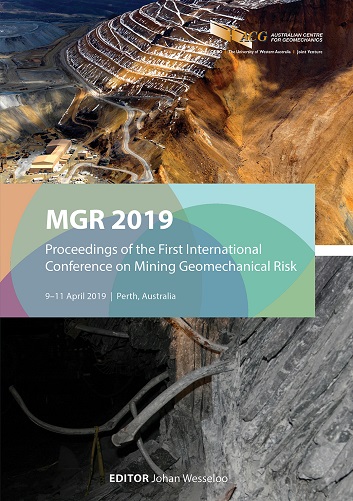Calibrating and testing of the forecasts of seismic hazard for planned mining sequences

|
Authors: Malovichko, DA |
DOI https://doi.org/10.36487/ACG_rep/1905_13_Malovichko
Cite As:
Malovichko, DA 2019, 'Calibrating and testing of the forecasts of seismic hazard for planned mining sequences', in J Wesseloo (ed.), MGR 2019: Proceedings of the First International Conference on Mining Geomechanical Risk, Australian Centre for Geomechanics, Perth, pp. 245-258, https://doi.org/10.36487/ACG_rep/1905_13_Malovichko
Abstract:
The forecast of seismic hazard in mines depends on the planned mining sequence and therefore it is required to: 1. Model the changes in stresses and strains associated with future mining. 2. Transform these changes to the parameters of expected potentially damaging seismic events (location, time, size, mechanism). This modelling of expected seismicity has to be calibrated. It needs to be shown that the recorded seismic response to the mining in the past can be replicated using a numerical model. The seismic hazard calculated for future mining steps also needs to be tested against the observed seismicity after the planned mining is completed. The same mathematical framework can be used for both the calibration and the testing of seismic hazard forecasts. The area skill score (Zechar & Jordan 2008) is adopted to assess the match between the location of significant seismic events and calculated hazard maps for the past mining steps (calibration) and forecast maps for the future mining steps (testing). The 3D rotation angle (Kagan 2007) is used to compare the source mechanisms of recorded significant seismic events with the expected mechanisms for the past and future mining steps. The seismic events affecting the poor performance of the forecast both in terms of location and source mechanisms can guide possible adjustment to the input parameters of the model (e.g. orientation of in situ stress, failure criteria) and help to improve the forecasts. The suggested approach of calibrating and testing of seismic hazard forecasts is illustrated using data from Renison mine, Australia.
Keywords: modelling of seismicity, area skill score, 3D angle of earthquake double-couple rotation
References:
Field, EH 2007, ‘Overview of the working group for the development of Regional Earthquake Likelihood Models (RELM)’, Seismological Research Letters, vol. 78, no. 1, pp. 7–16.
Kagan, YY 1992, ‘Correlations of earthquake focal mechanisms’, Geophysical Journal International, vol. 110, pp. 305–320.
Kagan, YY & Jackson, DD 1994, ‘Long-term probabilistic forecasting of earthquakes’, Journal of Geophysical Research, vol. 99, no. B7, pp. 13685–13700.
Kagan, YY 2007, ‘Simplified algorithms for calculating double-couple rotation’, Geophysical Journal International, vol. 171,
pp. 411–418.
Malovichko, D & Basson, G 2014, ‘Simulation of mining induced seismicity using Salamon–Linkov method’, in M Hudyma & Y Potvin (eds), Proceedings of the Seventh International Conference on Deep and High Stress Mining, Australian Centre for Geomechanics, Perth, pp. 667–680.
Mendecki, AJ 1997, Seismic Monitoring in Mines, Chapman and Hall, London, p. 262.
Mendecki, AJ 2016, Mine Seismology Reference Book: Seismic Hazard, Institute of Mine Seismology, 88 p.
Schorlemmer, D, Gerstenberger, MC, Wiemer, S, Jackson, DD & Rhoades, DA 2007, ‘Earthquake likelihood model testing’, Seismological Research Letters, vol. 78, no. 1, pp. 17–29.
Schorlemmer, D, Werner, MJ, Marzocchi, W, Jordan, TH, Ogata, Y, Jackson, DD, Mak, S, Rhoades, DA, Gerstenberger, MC, Hirata, N, Liukis, M, Maechling, P, Strader, A, Taroni, M, Wiemer, S, Zechar, JD & Zhuang, J 2018, ‘The collaboratory for the study of earthquake predictability: achievements and priorities’, Seismological Research Letters, vol. 89, no. 4, pp. 1305–1313.
Wesseloo, J 2013, ‘Towards real-time probabilistic hazard assessment of the current hazard state for mines’, in A Malovichko & D Malovichko (eds), Proceedings of the Eighth International Symposium on Rockbursts and Seismicity in Mines, Geophysical Survey of Russian Academy of Sciences, Obninsk, and Mining Institute of the Ural Branch of the Russian Academy of Sciences, Perm, pp. 307–312.
Zechar, JD & Jordan, TH 2008, ‘Testing alarm-based earthquake predictions’, Geophysical Journal International, vol. 172,
pp. 715–724.
Zechar, JD 2010, Evaluating Earthquake Predictions and Earthquake Forecasts: A Guide for Students and New Researchers, Community Online Resource for Statistical Seismicity Analysis, viewed 25 November 2018,
© Copyright 2025, Australian Centre for Geomechanics (ACG), The University of Western Australia. All rights reserved.
View copyright/legal information
Please direct any queries or error reports to repository-acg@uwa.edu.au
View copyright/legal information
Please direct any queries or error reports to repository-acg@uwa.edu.au
